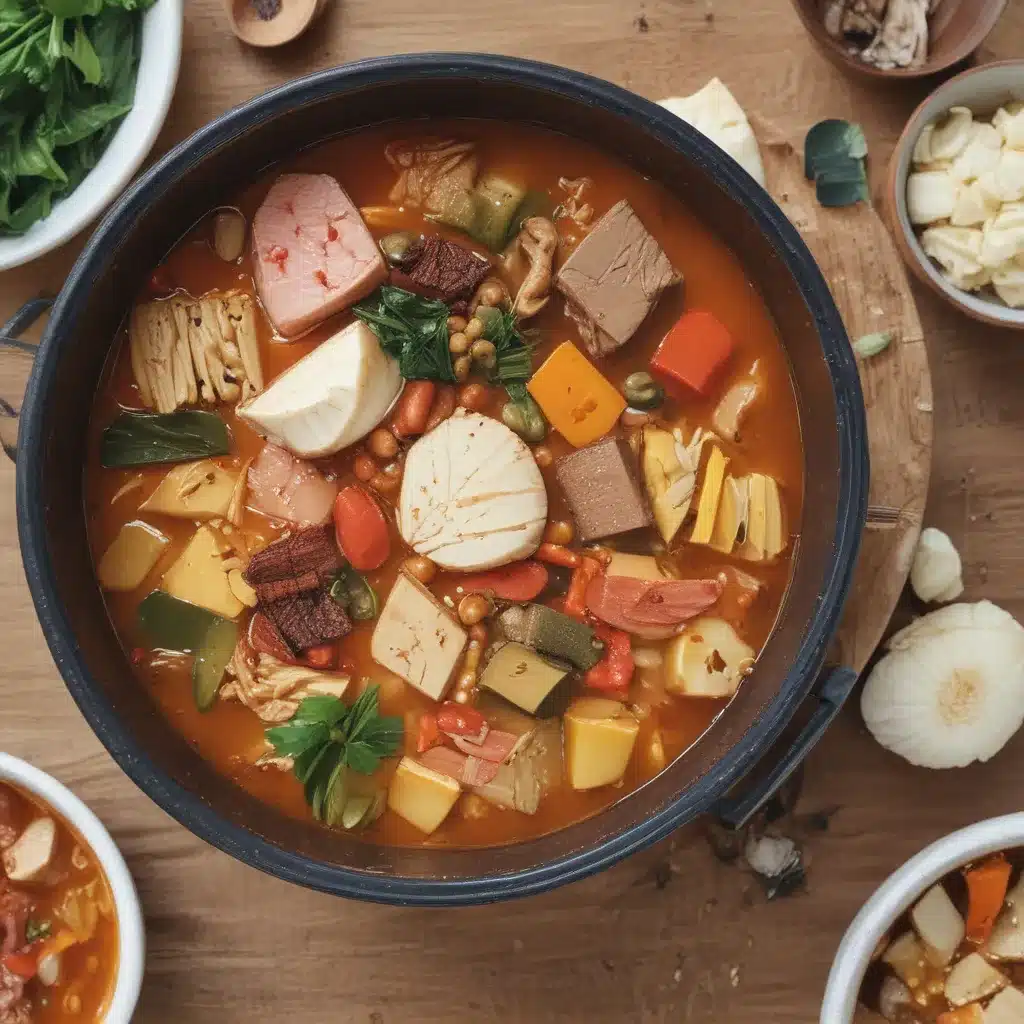
Korean Stews: Rich & Comforting Jjigae
When the temperatures dip and the wind bites, there’s nothing quite like a steaming hot Korean stew, or jjigae, to warm the soul. These hearty, flavor-packed dishes have been a beloved part of Korean cuisine for centuries, offering comfort and nourishment in every savory spoonful.
Among the pantheon of Korean stews, jjigae stands out as a true culinary icon – a versatile, deeply satisfying dish that can be tailored to suit every palate. From the fiery, kimchi-laced kimchi jjigae to the silky smooth, savory goodness of doenjang jjigae, these stews are the embodiment of Korean home cooking at its finest.
Kimchi Jjigae: A Spicy Celebration of Fermentation
Growing up, I can vividly recall the aroma of kimchi jjigae wafting through my childhood home, signaling the start of another cozy family meal. My mother, the master kimchi maker, would lovingly stir together the deeply fermented, pungent leaves with tender pork, fragrant garlic, and a touch of gochugaru (Korean chili flakes) to create a stew that was both comforting and invigorating. [1]
As the bubbling broth reached a rolling boil, the scent of kimchi would permeate every corner of the house, beckoning me to the table. There, I’d eagerly await the moment I could dive in, savoring the complex, sour-spicy flavors that danced across my palate. The softened, umami-rich kimchi pieces were a revelation, while the rich pork lent a luxurious mouthfeel to the stew.
Even now, whenever I’m far from home, it’s the memory of my mother’s kimchi jjigae that I crave the most. [1] There’s something about that fiery, flavor-packed broth that speaks to the very depths of my soul, reminding me of the warmth and togetherness that has always defined Korean family meals.
Doenjang Jjigae: The Comforting Hug of Fermented Soybean Paste
While kimchi jjigae may be the more well-known of the Korean stew clan, doenjang jjigae, or soybean paste stew, is no less deserving of adoration. This humble dish, made with the earthy, complex flavors of fermented soybean paste, is a staple of Korean home cooking, beloved for its ability to nourish both the body and the soul. [2]
As a child, I remember my mother preparing doenjang jjigae with the utmost care, carefully balancing the salty, savory notes of the soybean paste with the sweetness of vegetables and the umami depth of dried anchovies. The result was a stew that was both robust and remarkably comforting, a dish that seemed to wrap you in a warm hug with every bite.
Even today, whenever I’m feeling homesick or in need of a little extra comfort, a steaming bowl of doenjang jjigae is my go-to remedy. There’s something about the way the soft tofu and tender potatoes mingle with the rich, earthy broth that just feels like pure nourishment for the soul. [3] It’s a dish that transports me back to my mother’s kitchen, where the simple act of cooking was imbued with love and a deep sense of tradition.
Mastering the Art of Jjigae
While the recipes for classic Korean stews like kimchi jjigae and doenjang jjigae may seem daunting at first, the truth is that these dishes are surprisingly easy to prepare at home. The key lies in sourcing the right ingredients – from the pungent, well-aged kimchi to the savory, aromatic soybean paste – and then allowing the flavors to meld and deepen through slow, gentle simmering. [4]
One of the most important elements in crafting an authentic jjigae is the broth. Many traditional recipes call for the use of dried anchovies, which lend a deep, umami-rich complexity to the stew. [1, 3] However, for those who prefer a more vegetarian-friendly approach, you can easily substitute the anchovy broth with a flavorful stock made from mushrooms or even just the kimchi brine itself.
Another crucial factor in achieving jjigae perfection is the quality and fermentation stage of the key ingredients. The older and more pungent the kimchi or soybean paste, the more intense and satisfying the final stew will be. [1, 2] So don’t be afraid to reach for the most well-aged, funky specimens in your fridge or pantry – they’ll only make your jjigae that much more delectable.
A Comforting Culinary Journey
Whether you’re drawn to the fiery heat of kimchi jjigae or the warm, earthy embrace of doenjang jjigae, these Korean stews offer a culinary experience that is truly unparalleled. With their depth of flavor, nourishing qualities, and ability to evoke cherished memories, jjigae are not just dishes – they’re a window into the heart and soul of Korean home cooking. [1-4]
So the next time the chill of winter sets in, or you’re simply craving a little bit of comfort, I invite you to embark on a jjigae journey. Dive into the rich, savory broth, relish the tender morsels of pork or tofu, and let the flavors of fermentation work their magic. I can almost guarantee that with each spoonful, you’ll be transported to a place of warmth, nourishment, and pure culinary bliss.
References:
[1] Knowledge from https://omnivorescookbook.com/sundubu-jjigae/
[2] Knowledge from https://www.ahjummarecipes.com/single-post/2015/12/22/kimchijjigae-%EA%B9%80%EC%B9%98-%EC%B0%8C%EA%B0%9C
[3] Knowledge from https://chefchrischo.com/soybean-paste-soup-doenjang-jjigae/
[4] Knowledge from https://www.ahjummarecipes.com/recipes/category/Stews
